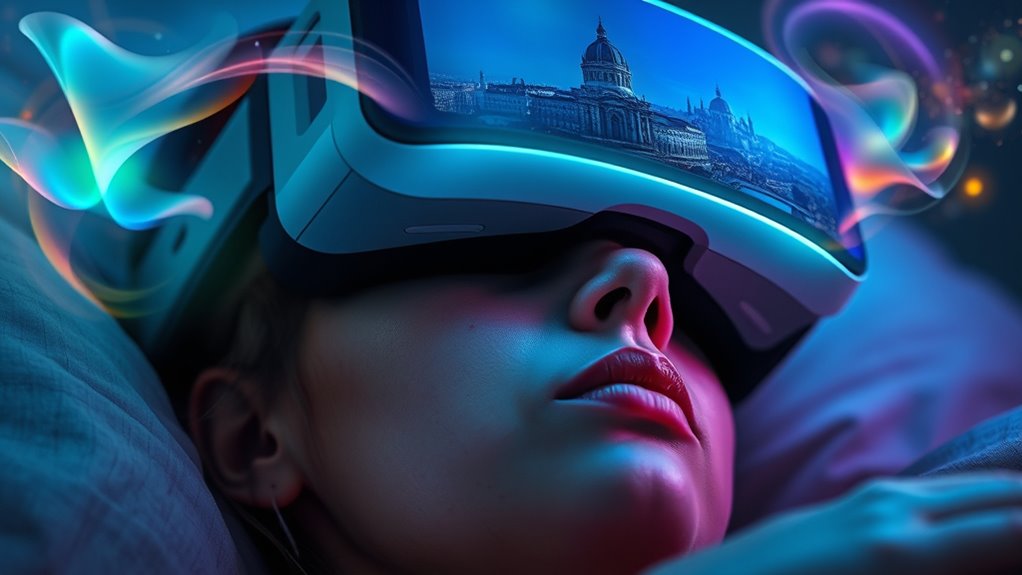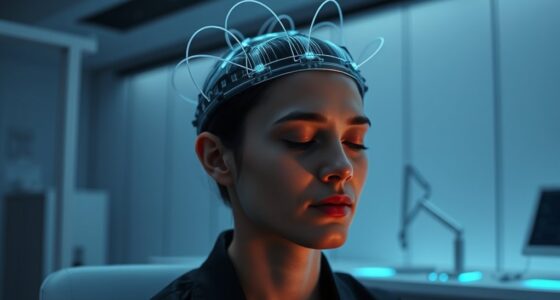When you experience virtual reality before sleep, your brain’s sensory systems tend to integrate those digital stimuli, causing virtual worlds to sometimes invade your dreams. This happens because neural pathways formed during VR sessions remain active during sleep, blending digital imagery with subconscious processes. As your brain adapts to virtual environments, these digital scenes can become part of your dream landscape, making your dreams vivid and immersive. To learn how this influences your sleep, keep exploring these fascinating brain-virtual world connections.
Key Takeaways
- Virtual reality experiences before sleep can be integrated into dreams through neural pathways formed during immersion.
- Sensory adaptation causes virtual stimuli to be incorporated into subconscious imagery, influencing dream content.
- Neural plasticity allows digital experiences to merge seamlessly with natural senses, blurring the boundary between real and virtual.
- Increasing VR technology makes it more likely for simulated worlds to invade sleep and affect dream landscapes.
- Understanding sensory fusion and neural processing helps manage how virtual worlds influence subconscious dreaming.

Imagine slipping into a virtual reality so immersive that it feels like a dream you can control. As you close your eyes, your brain begins to fuse digital stimuli with your natural senses through neural integration, creating a seamless experience that blurs the lines between the real and the simulated. This process isn’t just confined to your waking hours; sometimes, these virtual worlds extend into your sleep, infiltrating your dreams in ways you might not expect. When your mind processes virtual environments during sleep, sensory adaptation plays a vital role. Your brain adjusts to the artificial stimuli, filtering out or amplifying certain sensations, making the virtual world feel vivid and real even in your subconscious.
Virtual reality dreams blur the line between digital and subconscious worlds through neural integration and sensory adaptation.
During sleep, your brain remains remarkably active, especially in REM cycles, where dreams become most intense. If you’ve been engaging with virtual reality devices or immersive digital content before bed, your brain may carry over some of that sensory information into your dreams. This transfer occurs because neural pathways formed during your VR experiences aren’t erased just because you close your eyes. Instead, your brain continues to process and integrate these stimuli, which can lead to dreams that incorporate elements from your digital worlds. You might find yourself steering fantastical landscapes or interacting with characters from your digital worlds, all thanks to the neural pathways that connect these experiences to your subconscious. Additionally, sensory adaptation ensures that your brain becomes accustomed to virtual stimuli, influencing how these experiences manifest in dreams.
The phenomenon of virtual reality dreams isn’t just a quirk of the mind; it illustrates how adaptable and plastic your neural network truly is. When exposed repeatedly to simulated environments, your brain begins to treat these digital stimuli as part of its normal sensory input. Sensory adaptation helps you become comfortable with virtual worlds during your waking hours, but it can also cause these worlds to bleed into your dreams, making the lines between reality and simulation fuzzy. This blending can be both exhilarating and disorienting, as your mind struggles to distinguish what’s real from what’s virtual.
As virtual reality technology advances, the potential for these dream-invading experiences grows. You might wake up feeling like you’ve truly been somewhere else, even though you only visited a digital realm in your sleep. The key lies in understanding how neural integration and sensory adaptation shape these experiences. They highlight the profound influence digital worlds can have on your subconscious, blurring the boundaries of your sleep and waking life. Whether these virtual dreams offer new avenues for exploration or pose challenges to distinguishing reality from simulated worlds, they certainly reveal the astonishing adaptability of your brain and its endless capacity for merging the virtual with the real.
Frequently Asked Questions
Can VR Dreams Cause Long-Term Psychological Effects?
You might wonder if VR dreams can cause long-term psychological effects. While research is limited, intense or repeated dreams influenced by virtual reality could lead to neural conditioning, shaping your perceptions or beliefs over time. Some suggest dream therapy might help address any negative impacts. Staying aware of your sleep patterns and experiences can help you manage potential long-term effects, but more studies are needed to understand these impacts fully.
How Do VR Dreams Differ From Natural Dreams?
Imagine your mind as a sponge absorbing every detail; VR dreams differ from natural ones through vivid dream incorporation and sensory overlap. You experience sharper visuals and sensations, like living inside a video game, while natural dreams blend memories more seamlessly. VR dreams often feel more intense and immersive, making it harder to distinguish between reality and simulation. This heightened sensory experience can leave lasting impressions, unlike the more fluid, subconscious nature of natural dreams.
Are Certain Individuals More Prone to VR Dream Intrusion?
You might wonder if some people are more prone to VR dream intrusion. Neuroscience research suggests that individuals with certain psychological traits, like high suggestibility or vivid imagination, are more susceptible. Factors such as stress, sleep quality, and previous VR exposure also play roles. Recognizing these influences helps understand the psychological impacts and how your brain processes simulated worlds during sleep, making you more aware of your unique vulnerability.
What Technologies Are Used to Induce VR Dreams?
Imagine gentle whispers guiding your mind—this is how technologies induce VR dreams. Neural interfaces connect your brain to devices, allowing seamless communication. Sensory stimulation, like subtle vibrations or visual cues, helps create immersive experiences. Together, these tools craft a bridge between waking thoughts and dream worlds, enabling you to explore simulated environments even as you sleep. It’s a delicate dance of technology and consciousness, inviting new domains into your subconscious.
Can VR Dreams Be Shared or Experienced Collectively?
You can imagine VR dreams being shared or experienced collectively through shared dreaming or collective hallucinations. Advances in neural synchronization and brain-computer interfaces might allow people to connect their dreams, creating a shared experience. While still experimental, this technology could enable you and others to explore virtual worlds together during sleep, blurring the lines between individual dreams and collective hallucinations, transforming sleep into a shared, immersive adventure.
Conclusion
As you drift into sleep, these virtual worlds become whispered shadows dancing on the edge of your mind, blurring the line between reality and fantasy. Like a painter’s brushstroke seeping beyond the canvas, simulated dreams paint vivid scenes, blurring the boundaries of what’s real. Soon, your subconscious becomes a theater where virtual worlds play hide and seek with your memories, leaving you to wonder if you’re still dreaming or if reality has quietly slipped through your fingers like grains of sand.









